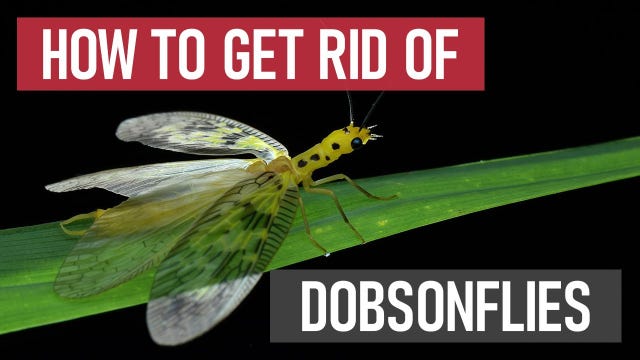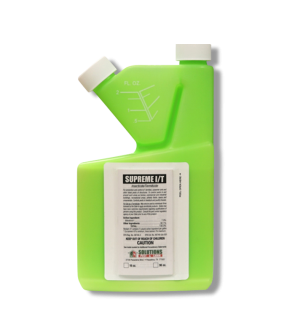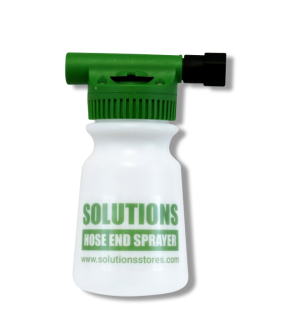Gain access to personalized product screening, the best pricing, rewards, and more!
Most Effective Products
Dobsonfly Control: How To Get Rid of Dobsonflies
This page is a general dobsonfly control guide. Using the suggested products and methods will reduce the likelihood of dobsonflies. Follow this guide and use the recommended products, and we guarantee a significant reduction in the population of dobsonflies.
Dobsonflies are aquatic insects commonly found along streams and rivers and you might find them hanging around in your structure, especially if you live close a running body of water. Despite their name, they are not flies at all. Dobsonflies belong to the order Megaloptera, which have two pairs of wings and are more closely related to alderflies and fishflies.
While their large mandibles might seem terrifying, dobsonflies are harmless to humans. They do not cause structural damage, bite, sting, or even transmit diseases. The females can bite, but these cases are sporadic, and their bite has no lasting effects. They are nuisance pests due to their tendency to invade in large numbers.
If you are dealing with a dobsonfly infestation on your property, our DIY control guide below will tell you how to get rid of the invasion using professional-grade control products and expert techniques.
Identification
Before you can proceed with a treatment program, you must be sure that your pest is indeed a dobsonfly. Misidentification can lead you to use the wrong treatment products and waste time and money. Below are some characteristics of dobsonfly to aid in identification:

- Dobsonflies are quite large insects, with adults typically measuring about 2.5 to 5 inches in length, including their wings. Their wingspan can reach up to 4 to 5 inches. They have elongated, somewhat flattened bodies that vary from yellow to darker shades of brown or gray, sometimes with a slightly mottled or speckled appearance. Their wings are translucent with a network of visible veins, which can give a patterned look but not bold colors or spots.
- Male dobsonflies are notable for their oversized, tusklike mandibles that resemble pincers, used mainly for mating displays, while females have shorter, sturdier jaws that they can use to bite and draw blood with.
- They also have long, thread-like antennae that extend forward from their heads.
- Dobsonfly larvae, commonly known as hellgrammites, are aquatic insects that can grow up to 4 inches in length. Usually dark brown to black in color, and have elongated, flattened bodies that help them stay hidden under rocks in streams and rivers. Hellgrammites have a tough, segmented exoskeleton with ridges and spines along their sides and back. Both male and female hellgrammites have mandibles they can use for catching and eating other aquatic insects. At the rear end, they have several pairs of small, hooked prolegs that help them cling to surfaces underwater. Between one and three years, sometimes even four years are spent in the larvae cycle for the dobsonfly.
Use the image and description above to identify dobsonflies on your property. If you are having trouble with identification, you can contact us for assistance.
Inspection
Once you have confirmed the infestation is dobsonfly, you can move on to inspection. During this phase, you will locate the areas where dobsonflies are infesting and observe the conditions allowing them to thrive. This information will help you determine where to apply pesticide applications.

Where To Inspect
Dobsonflies themselves don’t really infest homes or buildings, as they are primarily outdoor insects associated with freshwater habitats.
Their larvae develop in freshwater sites with fast-moving water such as streams and rivers, where they live under rocks and feed on other aquatic insects.
Adult dobsonflies usually stay near these water sources and are often attracted to lights at night.
Because dobsonflies do not feed or breed indoors and are not pests of wood or structures, they generally don’t infest homes. If you see them inside, it’s usually accidental more like they flew in from outside.
What To Look For
You're looking for standing water, excess moisture, and lights that might be attracting dobsonflies.
If you have identified areas where moisture builds up, or wherever lights illuminate in your home, this is where you will apply the treatment.
Treatment
Once you have confirmed the conducive conditions that attract dobsonflies. Remember to read all product labels, follow the application instructions on these labels, and stay safe by wearing personal protective equipment.
Dobsonflies are not typical household pests and generally do not infest homes, but if you’re seeing them around your property and want to reduce their presence, there are a few simple steps you can take.
Step 1: Address Light and Stagnant Water

Since the adult dobsonfly are strongly attracted to lights, reducing outdoor lighting at night or switching to yellow bug bulbs can help keep them away.
It’s also important to seal any gaps or cracks around windows, doors, and vents to prevent them from flying indoors. Using tight-fitting window screens and door sweeps can further reduce the chance of entry.
Because dobsonflies develop near clean, flowing water, reducing standing water or moisture sources around your property may also help discourage their presence.
Start by checking for standing water around your yard this includes birdbaths, clogged gutters, plant saucers, buckets, and unused containers. Empty or clean these regularly.
Make sure your gutters and downspouts are clear and directing water away from the foundation. Fix any leaky outdoor faucets, hoses, or irrigation systems that may be creating wet spots near your home.
If you have a pool, make sure to keep it covered when not in use.
In the landscape, ensure the ground slopes away from the house so water doesn’t pool near the foundation.
Inside the home, use dehumidifiers in damp areas like basements, and fix leaky pipes or plumbing promptly.
While dobsonflies themselves don’t breed in stagnant water (they need clean, flowing streams), reducing moisture overall helps discourage other insects and prevents dobsonflies from being attracted to your home environment, especially if you live near a creek or river.
Step 2: Apply Supreme IT

Using a residual insecticide like Supreme IT can help reduce the presence of dobsonflies around your home, especially if they are gathering near doors, windows, or outdoor lights.
While dobsonflies don’t infest homes or breed indoors, they can be a nuisance if attracted to your property by moisture or lighting.
We recommend using Supreme IT as a outdoor barrier treatment around your home.
Supreme IT is a bifenthrin-based insecticide concentrate that will work against 70 insects, including dobsonflies. Once applied, it will create a powerful 90-day residual barrier.
Determine how much Supreme IT Insecticide you will need to mix by first measuring the square footage of the treatment area. To do this, measure the treatment area's length and width in feet, then multiply them together (length x width = square footage).
For general treatment, use 1 fl. oz. of Supreme IT with 1 gallon of water to treat 1,000 square feet.
You will need to mix with water in a handheld pump sprayer or backpack sprayer.
Once mixed, you will do a perimeter treatment around your structure.
To do this, you will need to spray three feet up and three feet out from the foundation of your structure. Spray in this manner, all around the perimeter of your property. You will also spray the window frames, door frames, eaves, soffits, rain gutters, and electrical/plumbing penetrations.
Do not let people or pets enter areas treated until the spray has dried.
This product may not be applied to any grass or turf area within 100 feet of a water body (lake, pond, river, stream, wetland, or drainage ditch).
Prevention
Once the dobsonfly problem has been treated, you will want to make sure that they don't make a return. Prevent dobsonflies from returning with the following preventative methods:
- To start, turn off all outdoor lighting at night, as dobsonflies are strongly attracted to bright lights. If this is not possible, consider switching the light bulbs to yellow bug bulbs, which attract fewer insects. Also, remember to keep curtains closed in all windows, especially at night.
- Next, seal entry points around your home make sure windows and doors are properly screened, and seal any cracks or gaps where insects might slip inside.
- If you live near a stream, river, or other clean water source (where dobsonfly larvae develop), you can’t eliminate their habitat, but you can make your home less appealing by reducing nearby moisture. Fix any leaky outdoor faucets, clean gutters regularly, and ensure water drains away from your foundation. If you have a pool, keep it covered from May to August, as adults are actively searching for sites to lay their eggs during this time.
- Finally, spray Supreme IT every 3 months, before the dobsonflies hatch. This will give you added protection during the season when they are most likely to invade.
Key Takeaways
What Are Dobsonflies?
- Dobsonflies are an aquatic insect that frequents streams, lakes and rivers to breed and feed. They may be a nuisance pest inside a home due to their attraction to light.
How to Get Rid of Dobsonflies
- We recommend using Supreme IT Insecticide as a perimeter treatment to keep dobsonflies away from the home.
Prevent Dobsonflies Reinfestation
- Prevent dobsonfly infestations in the future by changing outdoor lighting to yellow bug light bulbs, covering bodies of water like pools and spraying preventative applications of Supreme IT.









